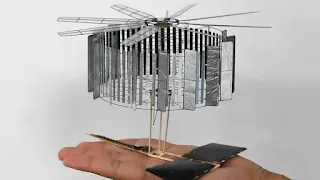 |
| Beijing Scientists Develop World’s Smallest and Lightest Solar-Powered Drone for Long-Distance Aerial Reconnaissance Image credit: Natures Journal |
Beijing scientists have unveiled what they claim to be the world’s smallest and lightest solar-powered drone, named CoulombFly. This remarkable 4.21g device, with a wingspan of 200mm, has achieved the milestone of flying non-stop during daylight hours. According to IEEE Spectrum, CoulombFly is approximately 10 times smaller and 600 times lighter than the previous smallest sunlight-powered drone.
The most significant innovation in the CoulombFly design is its use of electrostatic motor technology, which marks a departure from the electromagnetic motors used in earlier solar-powered drones. Electromagnetic motors lose efficiency when miniaturized to the sizes needed for micro aerial vehicles (MAVs), whereas the 1.52g electrostatic motor in CoulombFly delivers a lift-to-power efficiency between 200 and 300%.
This electrostatic motor employs lightweight carbon fiber and aluminum foil slats in nested rings, powering a 200mm propeller. Additionally, the 60 x 40mm solar cells, made with high-power-density thin-film gallium arsenide technology, weigh less than half a gram in total.
 |
| Testing CoulombFly Image credit: Natures Journal |
In testing, CoulombFly could take off in under a second in natural sunlight. Its ability to operate continuously during daylight suggests potential uses in long-distance aerial reconnaissance. The drone can support an additional payload of nearly 1.6g, allowing for the installation of a rechargeable battery to extend flight time beyond sunset. The scientists involved see further optimization possibilities for the motor, propeller, and circuits.
Despite the impressive achievement of CoulombFly, the researchers view this project as a stepping stone. They are also developing a prototype drone that measures about 8mm wide and weighs just 9mg, comparable in size and weight to a mosquito. However, this mosquito-like solar-powered drone cannot yet stay airborne on its own power. One of the professors working on the project expressed optimism, stating, “I believe that with the ongoing development of microcircuit technology, we can make this happen.”




.png)





0 Comments